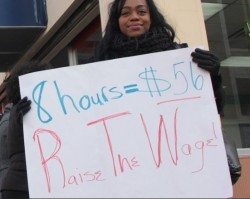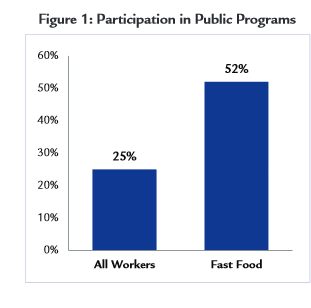Labor & Economy
Report: Fast-Food Workers Have One Foot in Poverty

A new study released today by the University of California, Berkeley Labor Center estimates that taxpayers contribute around $7 billion annually to provide basic social service benefits and health care to families of America’s expanding ranks of low-wage fast-food workers. The study, Fast Food, Poverty Wages: The Public Cost of Low-Wage Jobs in the Fast-Food Industry, also found that:
- Families of fast-food workers are twice as likely as the general workforce to be enrolled in one or more public assistance programs — a group that includes more than half of families with a member working full-time hours.
- One in five families with a fast-food wage earner has an income below the federal poverty line.
- Only 13 percent of the fast-food workforce receives health care. The Berkeley study looks at what it terms “core non-managerial front-line fast-food workers” in order to document what it said was the “hidden public cost of low-wage work” between the years 2007-2011.
 Focusing on Medicaid, food stamps, the Earned Income Tax Credit and Temporary Assistance for Needy Families, researchers estimated the total cost of those programs for all working families during its study period at $243 billion. The study notes, however, that the fast-food industry stands out for its low wages and lack of full time work hours. The report pegged the median hourly wage for employees working at least 27 weeks a year and 10 hours a week at $8.77 an hour.At a median of 30 hours per week, that puts a full time employee with a family of two at well below basic subsistence.
Focusing on Medicaid, food stamps, the Earned Income Tax Credit and Temporary Assistance for Needy Families, researchers estimated the total cost of those programs for all working families during its study period at $243 billion. The study notes, however, that the fast-food industry stands out for its low wages and lack of full time work hours. The report pegged the median hourly wage for employees working at least 27 weeks a year and 10 hours a week at $8.77 an hour.At a median of 30 hours per week, that puts a full time employee with a family of two at well below basic subsistence.
The study comes out at a time when such industry leaders as McDonald’s, Burger King Corp., Wendy’s and KFC Corp. have come under increasing fire by labor groups protesting what they call the corporations’ “starvation wages”; unions have also been seeking to organize the country’s estimated 4.1 million fast-food workers.
The researchers’ hard data promise to add ammunition to those efforts.
In addition to its implication that public poverty programs amount to a government subsidy for some of the nation’s wealthiest and largest employers, the study also overturns some popular misconceptions about who exactly is flipping our burgers, frying our chicken and serving our lattes.
The impression of the fast-food worker as a teenager living at home with his or her parents, for example, turns out to have little basis in fact. Rather, the study shows that workers under the age of 19 and living with a parent comprise a mere 18 percent of this workforce, a far smaller share than the 26 percent with children of their own or the 68 percent that are not in school and are single or married adults with or without children.
Of the $7 billion in public aid spent annually on fast-food workers, $3.9 billion goes to Medicaid and the State Children’s Health Insurance Program (CHIP), while food stamp benefits account for $1.04 billion, and Earned Income Tax Credit payments make up another $1.95 billion.
The nation’s other non-exporting industries — the largely non-unionized leisure and hospitality, retail and construction workforces — also registered a high concentration of households receiving public support, despite those industries’ relative immunity from competitive global wage pressures.
Fast Food, Poverty Wages joins a series of studies in recent years that have been have been examining and upending long-held assumptions about the true economic costs and social effects of low wages, while creating political momentum for living and minimum wage laws, and benefits capable of raising the service industry workforce out of poverty. A companion report, Going Nowhere Fast, was also released today by the National Employment Law Project and details the findings of the Berkeley report on a company-by-company basis.
-

 Latest NewsApril 3, 2024
Latest NewsApril 3, 2024Tried as an Adult at 16: California’s Laws Have Changed but Angelo Vasquez’s Sentence Has Not
-

 Latest NewsApril 17, 2024
Latest NewsApril 17, 2024Despite Promises of Transparency, California Justice Department Keeps Probe into L.A. County Sheriff’s Department Under Wraps
-

 Latest NewsMarch 20, 2024
Latest NewsMarch 20, 2024‘Every Day the Ocean Is Eating Away at the Land’
-

 State of InequalityApril 4, 2024
State of InequalityApril 4, 2024No, the New Minimum Wage Won’t Wreck the Fast Food Industry or the Economy
-

 State of InequalityApril 18, 2024
State of InequalityApril 18, 2024Critical Audit of California’s Efforts to Reduce Homelessness Has Silver Linings
-

 State of InequalityMarch 21, 2024
State of InequalityMarch 21, 2024Nurses Union Says State Watchdog Does Not Adequately Investigate Staffing Crisis
-

 Latest NewsApril 5, 2024
Latest NewsApril 5, 2024Economist Michael Reich on Why California Fast-Food Wages Can Rise Without Job Losses and Higher Prices
-

 Latest NewsMarch 22, 2024
Latest NewsMarch 22, 2024In Georgia, a Basic Income Program’s Success With Black Women Adds to Growing National Interest




















